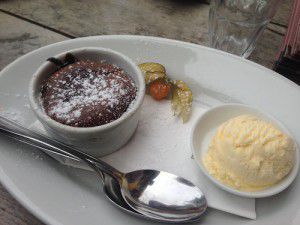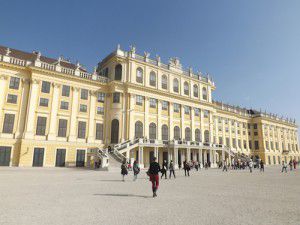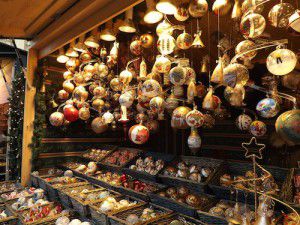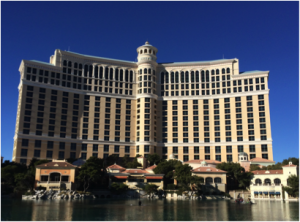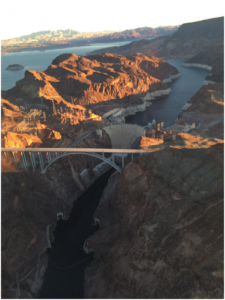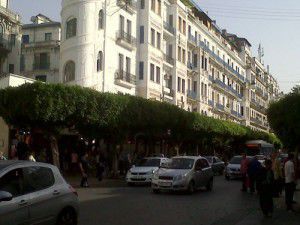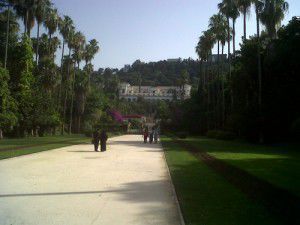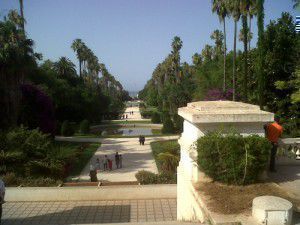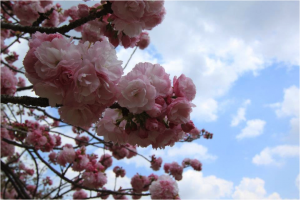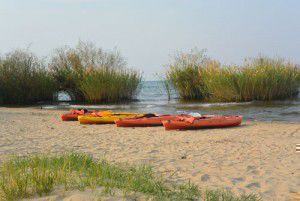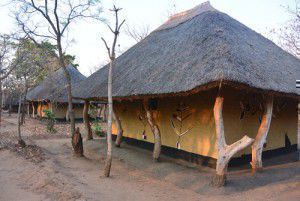10 reasons to visit Vienna
Today’s ’10 reasons’ guest post comes from Charlotte, who’s currently living and working in Vienna, Austria. If you’d like to read more from Charlotte, you can follow her blog or find her on Twitter.
So here are 10 reasons to visit Vienna… Do you have any to add?
1. Have you seen how pretty it is?
One of the first things you’ll notice, if you go to Vienna, is the architecture. You name an architectural style and there are probably buildings in Vienna based on it, in some shape or form. And even if you’re not a massive fan of the City Hall, or the Burgtheater, then there are plenty of places to enjoy more modern buildings and designs, like the huge Main Public Library or even sitting on the Enzis (some colourful outdoor furniture) in the inner courtyard of the MuseumsQuartier. My favourite building in Vienna is the Hundertwasserhaus, a definite must see – and it’s not like it costs anything to look at it!
2. You can catch an opera or go to a museum.
There’s certainly plenty to choose from in the opera department. The Vienna State Opera (Staatsoper) offers more than 350 performances per season – that’s ballet, opera, and different concerts. If you don’t mind standing, it’s also not too expensive, though you do have to queue for a while beforehand. However, this is one of those things I would recommend if you aren’t in a hurry and you have a little bit of extra cash. Where would be a better place to see an opera but this historical city in a country famous for its musicians? Plus, there are a lot of museums in Vienna. There’s the Natural History Museum, the Art History Museum, the Leopold Museum, the Jewish Museum, the Museum of Technology… There are, in fact, over 100 museums in this city. Some of them are old palaces – like Belvedere or Liechtenstein City Palace – and some of them might seem odd – like The Third Man Museum or the Funeral Museum – but they’re all interesting and there’s something here to suit everyone.
3. You can eat at the Naschmarkt.
I’m not going to lie, the Naschmarkt is one of my favourite places in Vienna, for one reason only – it sells food. It’s around 1.5km long and people there sell spices, fresh fruit and vegetables, cheese, seafood, meats, bread… You name it and they probably sell it there. Plus, there are a bunch of small restaurants where you can sit and eat anything from Chinese dumplings to baklava to traditional Viennese food like Palatschinken. Yum!
4. You can chill out on the Donauinsel.
The Danube runs through Vienna, as it does through many other European cities, but here they’ve got an island that runs along the middle of it and you can reach on the subway. Especially popular in the summer, you can sit and have a picnic, or read, or do what others are doing and rollerblade or bike around it. Plus, every year they hold the Donauinselfest, an outdoor music festival and Europe’s biggest open-air event. Considering that its main purpose is to protect Vienna from flooding, it has developed into one of the main areas of entertainment in the city and is a lovely place to waste away a day or three.
5. You can – and should – eat Sachertorte.
Sachertorte is to Vienna what the Victoria Sponge is to the UK – maybe people don’t eat it every day, but they’re certainly aware of its existence and will take the time to explain to you that you should try it as soon as possible. What it actually is, is a dense, delicious, chocolate cake with dark chocolate icing, held together by apricot jam (yes – the apricot jam might seem a little strange at first, but when you consider that in the Austrian dialect they actually have their own separate word for apricot, then you’ll understand that you’re going to come across it often and maybe in surprising places). The ultimate place to eat it, apparently, is at the Hotel Sacher, but you can buy Sachertorte at probably every café in the city. Make sure you get a slice if you’re in Vienna on the 5th December – that’s National Sachertorte Day.
6. Vienna has the oldest zoo in the world!
You may have already heard of Schönbrunn Palace, which is an imperial summer palace and worth a visit, particularly on a sunny day. Well, on the same grounds is the Tiergarten Schönbrunn (Schönbrunn Zoo), which, having been founded in 1752, claims to be the oldest zoo in the world. It is one of a few zoos to house Giant Pandas (including three that were born in the zoo) and currently houses over 700 species. It is also one of few attractions in Vienna that is open 365 days a year (most things close on Sundays) – so you can go whenever you feel like it.
7. You can visit St. Stephen’s Cathedral.
It can get a bit dull visiting churches and cathedrals all the time, especially in a country like Austria, which is teeming with them, but if you only choose to visit one, then choose this one. This is Vienna’s landmark and it is the most important religious building in the city, and if you don’t feel like just going in for a look around, there is always the opportunity to attend a concert here instead. Plus, it sits on Stephansplatz, basically the city centre, so it’s not like you’ll miss it.
8. It’s an easy task to go wherever you want.
So maybe I shouldn’t highlight ways to leave the city in a post about why you should go there, but considering Vienna’s – and Austria’s – position in Europe, this was bound to come up. The fact is, it’s really easy to go somewhere else and, in most cases, it’s quite cheap too. It’s an hour to Bratislava; you just hop over the border into Slovakia and it’s less than 20€ for a return ticket. It’s three hours to Budapest, the other capital of the Austro-Hungarian empire (and worth a visit if you’re interested in exploring that theme) and four hours to Munich, or Innsbruck, or Prague. You can get cheap tickets to all of these places too, provided that you book in advance or that you get hold of some kind of discount card (not difficult to do). So, you know, if there isn’t quite enough to keep you entertained in Vienna, you can always make a quick trip somewhere else.
9. You can visit the Prater.
The Prater is a huge public park in Vienna, but probably the most famous part of it is the Wurstelprater amusement park, which takes up one corner. This is the home to the Wiener Riesenrad (the Ferris wheel), along with plenty of other rides, but also restaurants, bars, a Madam Tussauds and at least one night club. You could spend a day and a night here, if you wanted, as there’s plenty to do and as it costs nothing to get in (you pay per attraction), you can just wander around the park and explore.
10. If you come in December, you can visit a Christmas Market or five.
Much like the thing with the apricots, the Austrians have a different name for Christmas Markets (Christkindlmarkt) to their German counterparts, but the principle is somewhat similar. Late October to early November, you’ll see the stands being built and lights being strung – and then from the first weekend of November, the markets begin to open, selling drinks and food and decorations and gifts. I’m not sure exactly how many Christmas Markets there are, but essentially they’re everywhere, so you’ll just stumble across them as you wander the city. Like Germany, Glühwein (mulled wine) is a big thing here, but so is punch – and if you’re not so into the wine, you can buy Glühbier (mulled beer) in certain places. If you don’t drink at all, then there are plenty of places that offer non-alcoholic punch, in a variety of places. So, get a drink, buy yourself some food and soak up that festive atmosphere!
Charlotte
xuexisprachen.wordpress.com
@luna_moonsilver
(Photo credit: Charlotte Donnelly)
Do you have a favourite place that everyone should know about? Let us know!
10 reasons to visit… Las Vegas
I was lucky enough to visit one of the most notorious party cities last December; I, however, can not comment on what the night life is like in Vegas as I was only 19 and therefore not allowed to step foot into a bar or club! However, even without the partying there is so much to do in Vegas, as well as lots of places to see. We flew out on the afternoon of Friday 13th, on a plane which contained a lot of nervy people as well as plenty of bachelor and bachelorette parties. We were only there for four days and it was non-stop. Here are my top ten reasons to visit Las Vegas.
1. The Shows
Walking down the strip you can see endless advertising for different shows, concerts and celebrity residences. They all seem that much better over in Vegas; maybe this is because of the additional glitz and flashing lights, or just getting caught up in the buzz of the city. I would highly recommend going to see at least one type of show, as it is a completely different energy and atmosphere.
2. The People
Everyone in Vegas was so friendly. People couldn’t do enough for you, they were always trying to make your experience the best it could be. This didn’t just include staff working in the hotel but everyone on the strip; if people saw you were a group and one was taking a photo of everyone else, someone would always offer to take a group photo of you. People were all so chatty and friendly and even when you were approached by a salesman on the street once you said no they didn’t pester you, they still smiled and said ‘Have a great day’, how often does that happen here in the UK?
3. The Buildings
When watching the films, you expect the strip to go on for miles and miles. However, when you are there it isn’t nearly as long as you expect. Also all of the different styles of buildings you see, ranging from the classic Bellagio to the new styles such as the Wynn. You also have character buildings such as the New York, New York and the Luxor; just viewing them from the outside there is always something different to see.
4. Entertainment
When you are walking along the strip there is always someone or something to see. Ranging from the famous fountains at the Bellagio, to a volcano exploding in front of the Mirage and the pirate show in front of Treasure Islands, which was unfortunately under construction when we were there. There were many different types of people in fancy dress, ranging from Alan in The Hangover to Bumblebee from Transformers, who can actually turn himself from a car to a person! It is simply not possible to walk down the strip and be bored.
5. Casinos
Every hotel has a casino and each one is slightly different. When sitting at a slot machine or one of the numerous machines they have spread throughout the floor, you can really lose track of time. There are no windows and you see people sitting at the tables for hours on end. Often in the morning when you walk through the casino you see people still playing who haven’t left from the night before. Long gone are the days of inserting ‘quarters’ into the machine and pulling the handle; it is now dollar bills and pressing a button. It was rare to find a machine with a handle and it was so exciting when you did find one. Once you are there you can see how people do become addicted; just waiting for the sheet of paper to come out of the machine to tell you how much you have won, and then queuing in anticipation to collect your money. You quickly get into the ‘oh, just one more time’ mind set…
6. Lobbies of Hotels
Each hotel lobby holds something different to entice you in further towards the casinos, restaurants and shops. You want to walk into each hotel and see what they have on show. Most of the hotels were truly spectacular, especially in December where lots had a Christmas theme.
7. Grand Canyon
Undoubtedly one of the most beautiful sights you will ever see. Even if you aren’t there for long, there are various trips you can pick from, ranging from a short helicopter ride over the canyon, to an all-day adventure including having lunch in the canyon. It is a sight you will never forget and you will never see such a vast range of colours anywhere else.
8. The Shopping
An experience I have never had before. In Caesar’s Palace, walking from shop to shop, even though you are inside, you would never know. The ceiling is done in such a way that it feels like you are outside, and even simulates rain and thunderstorms. Or there is the Venetian, with the canal running throughout the ground floor where you can catch a gondola and be serenaded by a gondolier. You won’t experience shopping like this anywhere else in the world.
9. The Chocolate Fountain in the Bellagio
Something you can stand and stare at for hours wondering how it was possible to make – at first it is very hard to tell that it is even real. It is the world’s largest chocolate fountain and took a year and a half in planning and designing alone. For all of the chocolate lovers out there, it is a sight not to be missed.
10. The Food
Every different type of food you could possibly want, you can find in Vegas. The portions are huge, so sharing is definitely recommended if you aren’t overly hungry. At breakfast, when you order pancakes you don’t just get one or three, you get a stack of at least five. Vegas is also renowned for its buffets, where you pay a fixed price and you can go up as many times as you want. These aren’t just any buffets though, they have everything you could possibly want: Chinese, Italian, Seafood… anything and everything.
Even without the partying aspect of Vegas it is still the best city I have ever been to; the list of reasons to go could go on for a very long time.
Have you been to Vegas? What were your best bits?
Amy
10 reasons to visit… Algiers
I must admit that Algeria does not feature highly among people’s bucket list destinations.
While most tourists visiting the region flock to Egypt or Tunisia, Algeria is still very much off the beaten track. Nor does it help that it has attracted a rather bad press over the last year or so: much of the country is a security risk and the FCO advises against all travel to half of the Algeria, and all but essential travel to much of the rest.
Chickened out? Well, there is always its next door neighbour Morocco, which admittedly has done much to develop its tourist industry over the years.
‘Ah but I’ve been there already’, you say, ‘I’ve stayed in a posh riad, I’ve had a ride on a camel and I’ve stocked up on more of those pointy slippers than I’ll ever need.’
Quite. So you’re looking for the real deal, are you? Well, the good news is that Algiers, the capital, is very much worth the detour, untouched by Easyjet, and better still, firmly in the ‘OK to visit, but be careful’ bit of the country. I was lucky enough to go twice, and here I am writing this: all bodily parts present and correct, wallet intact, and dignity unscathed.
As it happens, I was working on a project with one of the government ministries. This meant that I was fortunate enough to be met at the airport and whisked through immigration and customs in seconds. I also benefited from a security detail which picked me up and accompanied me wherever I went: a pair of friendly enough goons, wearing shades and Blues Brothers suits (sans hats), constantly tailing us in a slightly scruffy VW Polo – not a Bluesmobile.
So here are my ten reasons to visit Algiers (and a bit of the surrounding area):
1. The city centre
Algiers has a faded, run down beauty. The centre of the city is full of white stuccoed buildings in the French colonial style and you’ll love exploring the up-and-down streets and avenues. Pack a pair of stout walking shoes though, as it’s a hilly place. And as you take a break, sipping a coffee and people watching at one of the many excellent cafes dotted around town, you may be wondering where all the tourists have gone. Don’t worry: the last ones left circa 1962, so you really will have the place to yourself.
2. The view
You may find yourself in accommodation higher up and somewhat away from the city centre, with the city stretching out below you. Not for nothing is the city called ‘Alger la Blanche’.
3. Public transport
I found a little cable car that takes you down the hill (i.e. from the residential suburbs to the city centre) to the sea and Botanic Garden in just three minutes. There’s also a one-line metro that crosses the city, which, when I used it, was virtually empty. I wondered whether people had in fact been told it had recently opened – or maybe they simply refused to pay the 15p fare.
4. Cheap fuel
Petrol in Algiers costs only around 10p per litre. No, this is not a misprint for 110p. Algeria is, after all, still one of the world’s leading oil producers.
5. No retail chains
Should you require a fix from KFC, McDonalds, Zara, or any other global retailer for that matter, please leave Algiers immediately. To remind you, this is not Morocco. However, with your 4 X 4 filled up with 10p petrol you could probably drive there.
6. The food
If you enjoy your French food, you might like Algiers’ version of it. The seafood is excellent, especially when washed down with a glass of Oran wine, which is not bad at all. Alternatively, if you enjoy your coucous you’ll love the Algerian varieties. Do not expect Michelin star joints: most eateries are small and family run.
By the way, you will need to hone either your French or Arabic speaking skills when you negotiate your way around town, as very few people speak English. I strongly suggest a purchase of uTalk prior to departure.
7. The treats
Do you have a sweet tooth? There are countless well stocked patisseries wherever you look, with everything from tiny sugar dusted and intricately decorated almondy cakes to classic croissants on display.
8. Le Jardin d’Essais du Hamma
The botanical garden, Le Jardin d’Essais du Hamma, is lovely: classically designed, it is formal, tropical and a respite from the heat, especially if you’re visiting during the summer.
9. Tipasa
One day we were taken along the coast to the sleepy little seaside town of Tipasa, which goes back 2,000 years, and where it is possible to visit the remains of the Roman city. In fact Tipasa became one of the most important ports in Ancient Rome.
10. Notre Dame d’Afrique
If you are determined to venture high enough in the city you’ll find Notre Dame d’Afrique, a 19th century Catholic church, which is an official monument and commands views of the Bay of Algiers and the harbour. Its architecture is fascinating: a successful blend of Eastern and Western influences.
I can’t end my snapshot of Algiers without a quote from one of its best known sons. In his 1936 essay, ‘A Summer in Algiers,’ Albert Camus wrote: ‘In Algiers one loves the ordinary places: the sea at the end of every street, a certain volume of sunlight…’ What more can you ask for?
Steve
10 reasons to visit… Tokyo
To finish up our Japanese week, Safia’s written today’s blog post on her top ten reasons to visit Tokyo.
Do you live in Tokyo, or have you visited? Please share your own top tips in the comments!
1. The old and the new
Before I even start talking about specific points of interest, all you need to do is to walk down the street to see how traditional and modern Japanese culture both collide and sit beautifully side by side. Temples of all shapes and sizes pop up everywhere in between buildings and houses (many of which are open to the public), kimonos and yukatas are still worn as everyday wear and not just for special occasions, and I will never stop being excited about literally being able to buy anything under the sun from a vending machine.
2. Harajuku/Meiji Temple
For the weird, the wonderful and the fandom, Harajuku is the place to be to find the centre of Japanese youth and fashion culture. If you like to people-watch, there are usually a handful of cosplayers or colourfully dressed youths hanging around the station area and the backstreets are packed with little independent boutiques. In stark contrast, Meiji Jingu is also located here with the entrance round the corner from the station, and is an Imperial Shrine dedicated to Emperor Meiji and his wife Empress Shoken. If you’re lucky enough you may even get to see a wedding, as it is a popular venue for forthcoming nuptials.
3. Tsukiji Market
There are very few places in the world where I would consider waking up at 5am just to get some fish, but Tsukiji Market is definitely one of them. If the idea of raw fish (sashimi) sends you heaving, I urge you to give it another go for the love of tuna that just melts on your tongue. I promise when it’s this fresh and prepared this delicately there is nothing else like it, and there will be plenty of other sushi options as well. Personally as a foodie, I skipped straight to the food, but if you want to see the tuna auction you really have to get there early as there are limited spaces for viewers. Some of the queues for the restaurants can get quite long as well, but surely that’s just testament to how good it’s going to be inside?
4. Boat ride on the Sumida River
Take a journey down the river and under its many bridges to see Tokyo from a different point of view. Jump on at Asakusa where most of the water buses start from and you’re guaranteed to see at least twelve different bridges along this route. If architecture and design spark your interest then this is definitely a trip for you. And if sipping a cool beer on a boat on a sunny day sparks your interest then I’d say this is a trip for you too! There are various routes including a round trip, but I can recommend getting off at the Hama-rikyu gardens for an added sightseeing bonus.
5. Food
When it comes to food, where do I even start? I wouldn’t blame you if the first thing that came to mind was sushi followed swiftly by ramen, but there is so much more to Japanese cuisine. This section deserves its own blog post, but before I get too tempted let me recommend three things that I think you should definitely try on your trip (that doesn’t include sushi or ramen!):
Takoyaki (Octopus balls)
Bearing in mind that’s a literal translation, takoyaki is a batter cooked in a special pan filled with diced octopus, pickled ginger and various other ingredients, all brought together in a handy bite-sized ball.
Okonomoyaki (Grilled savoury pancake)
Quite often this pancake-like dish is cooked on a hot grill right in front of you with the main ingredient being cabbage. Be sure to check if it’s a grill-it-yourself establishment so you’re not sitting there twiddling your thumbs while everyone else is already tucking in!
Yakitori (Skewered food)
Basically, meat on a stick (and sometimes vegetables) but with some amazing local flavouring. If you can find it, there’s a brilliant little alleyway in Shinjuku where local eateries are crammed in next to and top of one another.
6. Izakaya
I can only describe an Izakaya as a cross between a pub and a tapas restaurant in a laid back and cosy setting. Although they can at first seem intimidating to a foreigner, they’re great for unwinding after a long day of sightseeing (or work) and getting acquainted with the locals. If you’re having a tough time looking for one, many still sport a traditional red lantern outside the premises. Food comes as and when ordered and ready rather than in courses and is usually shared between the group if you’re with other people.
7. Karaoke
Surely it’s not possible to go to the motherland of karaoke without actually going to a karaoke bar at least once? Even if you don’t like karaoke, you’re in another country and no one will ever know, unless you accidently post a picture on Facebook. So lose your inhibitions, grab that mic and belt out some tunes in a foreign language! Japanese karaoke is an altogether individual experience and there are such a variety of bars and boxes to choose from, whether you’d like to be surrounded by Hello Kitty memorabilia or even sing from a hot tub. Check out the Shibuya and Roppongi areas as a starting point.
8. Tokyo Tower
At a whopping 634m tall, Tokyo Tower is hands down one of the best ways to survey the city. If you need a break from the bustling streets below, I highly recommend popping up and having a little gander. The night time view is spectacular with Tokyo’s array of high rise buildings and bright lights. During the day if you’re lucky enough to have a clear sky, then you may even get to see some distant points of interest which are very handily marked around the tower for you, such as ‘Mt. Fuji, 97km, that way’.
9. Sakura (Cherry Blossom) season
Around April something magical happens in Japan and it’s called Sakura or Cherry Blossom season. As it’s seasonal the exact time of the year can vary, but if you manage to catch it the flurry of pink and white blossoms can be breathtaking. Sakura hot spots in Tokyo include Shinjuku Gyoen and Ueno Park, both boasting over 1,000 Sakura trees. Be prepared for crowds during peak season as popular areas can get amazingly crowded with Sakura enthusiasts.
10. Asakusa/Sensou-ji Temple
Asakusa definitely has a bit more of an older feel to it compared to some of Tokyo’s other more shiny districts like Ginza. Many of the buildings were built around the 1950s/60s since prior to this most were lost to bombs in war. This included one of Tokyo’s most popular temples Sensou-ji, which was originally built in the 7th century. It was rebuilt after WWII to symbolise peace and rebirth to the Japanese people. To get to the temple you’ll need to navigate your way through the Nakamise shopping street, which is lined with various street food stalls and tourist shops.
One final piece of advice – don’t assume that everyone in Tokyo will speak English, because they don’t! You’ll need to learn at least a few basic phrases before you get there.
Fortunately, there’s an app for that 😉
Safia
All photos property of Safia Griffin
10 reasons to visit… Malawi
Today’s post is by Alex from onebillion. As you may know, onebillion are an organisation set up by Jamie and Andrew from EuroTalk to provide basic maths, reading and English teaching through apps to children in developing countries (and they were recently featured in a BBC Click report). A few weeks ago, the whole onebillion team travelled to the African country of Malawi to expand their project to a new school.
Perhaps Malawi might not seem like an obvious choice for a visit, but here are ten reasons why Alex thinks you should give it a try 🙂
1. ‘Interesting’ foods
I’m not sure if this is a reason to visit Malawi or not, but it is quite interesting to see what some of the locals eat. Typical local cuisine mainly consists of a maize porridge called nsima, which they eat 2-3 times a day, but you can buy great-looking fresh fruits for next to nothing. You can also get international cuisine from some restaurants in Lilongwe or Blantyre (the two major cities). But a particular highlight is seeing the ‘mouse boys’ who sell sun-dried mice on sticks (complete with fur) on the side of the road. For some reason none of us has been brave enough to try one yet. You also have to drink some fresh-ground Malawian coffee – and bring back some beans for the EuroTalk and onebillion offices, of course!
2. Lake Malawi
This is one place you have to see before you die. The most beautiful place I’ve ever been to. You can stay in a simple straw beach hut, see the stars and wake up to the sound of the waves and nothing else. The lake is home to many varieties of fish, alligators and hippos, and we saw dozens of monkeys and other critters all around the lake. Including some rather terrifying new species of bugs. Be careful to check whether it’s safe to swim in the part of the lake you visit, but even if you can’t it’s an amazing place to see some stunning nature.
3. Get involved in a voluntary project
onebillion recently returned to Malawi to check up on our progress with delivering tablet-based learning in Biwi school and to expand to another, larger school. We were so excited to see how much progress the children have made with their maths skills. But there are many other organisations working there on things like building schools, digging wells and volunteering as a teacher or healthcare assistant. See Malawi Volunteer Organisation or VSO, for example.
4. See a totally different way of life
Even in Lilongwe, the capital, Malawi is not very developed. You’ll be bumping along mud roads and seeing people walk past with bicycles stacked up with insane quantities of firewood, huge towers of mud bricks being baked dry and barefooted children running around with chickens and goats. Just seeing how people go about their daily lives will give you a new perspective, and chatting to some of the locals and children who have never seen technology such as smartphones or tablets is really worthwhile. Seeing the faces of groups of Malawian children when they first play a maths game on a tablet or seeing our flying ‘drone’ camera was priceless.
5. Experience life without modern conveniences
You know all those things you take for granted, like running water, drinking water on tap, electric lights, flushing loos, wifi? Maybe try a couple of days in a traditional Malawian-style hut and say goodbye to all of those things for a while! Whilst freezing ‘showers’ from a bucket, candlelight and a few days without Instagram might be hard to get used to – it’s a really interesting experience which makes you appreciate all the home comforts you took for granted before. And you might find you see and experience something new when you’re forced to go without Facebook for a couple of days. Kumbali Village in Lilongwe is the perfect way to experience a back-to-basics stay but with clean water available and clean rooms too.
6. Wildlife!
One of the first things you’ll notice as you take a walk or drive around when you arrive in Malawi is all the different plants and animals that you’ll see everywhere. You can take a safari (the Swahili word for ‘journey’ by the way) or visit one of the country’s incredible national parks, such as Liwonde and Lengwe to see hippos, lions, elephants and more. But you’re likely to spot monkeys, baboons, colourful insects and birds just out and about. Just watch out for chickens, goats and dogs running in front of your car when you’re in one of the villages!
7. Climb Mount Mulanje
I didn’t actually do this when I visited, but Zane and Alan from onebillion did on their visit and said it gave them a really great sense of achievement, as well as an awesome view. Mt Mulanje is 9,849 feet high – quite a climb, but not requiring special equipment or training.
8. Friendly people
We often say this about a place, but in Malawi it really is true! Malawi is called the ‘warm heart of Africa’ and much of this is to do with how warm and friendly people are. They are really genuinely interested to talk to people from other places and happy to share their lives and interests with you in return. They’re also really happy if you manage a couple of simple Chichewa phrases: greet people with ‘moni’ (hello), say ‘zikomo’ (thanks) and ‘chonde’ (please) and you’ll get along fine.
9. Unspoiled landscape and scenery
Depending on the time of year, Malawi is either lush and green or dry and very dusty. However it is always a very impressive country to see, with a variety of different terrains and landscapes, including mountains, lakes and rivers. There are a lot of open spaces and not many tourists, so it’s a great place to see some real and unspoiled nature where commercialism hasn’t taken over yet.
10. The climate!
Ok, since our trips to Malawi are mainly about working on our ‘one billion children’ project we don’t have sooo much time for sunbathing. We’re normally up with the sunrise at 5.30am, in school all day and up charging and configuring tablets, processing data or marking until about 11. But there’s normally some time to relax as well, and sunbathing might also happen (only if our work is done first, honest). You might think of Malawi as extremely hot, but most of the year it is a really nice temperature around 30 degrees and not too humid. Remember your suncream (and insect repellent!) and it really is a great place to soak up some sun.
Alex
